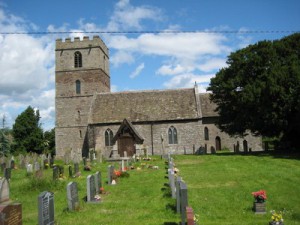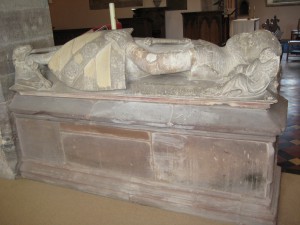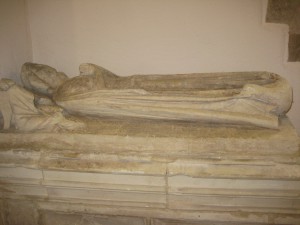This lovely Herefordshire church of All Saints was built during the 13th century, although there was once a Norman church on the site. This is one of few churches to have changed names following the original dedications, and in fact it used to be St. Mary’s. The first time that All Saints occurred was 1742.
When the St. Anne’s chapel was restored in 1956, it was found that the floor was actually covering an earlier floor of stone slabs, in which were many memorial stones. The inscriptions were unreadable, and most were removed when the new floor was laid, however when one of the slabs was taken up a stone coffin was found in which was a skeleton of a child between 12 and 16. The grave was closed again, but it is thought possible that it was Henry Pembrugge who died aged 15 in 1375; he was the son of Sir Richard Pembrugge of Clehonger Manor. Two memorial slabs were kept, and they were for members of the Aubrey family who also had Clehonger Manor from 1600 to 1794, when the Manor suffered a dreadful fire.
Font
Memorials
Sir Richard Pembrugge
There is an effigy of Sir Richard Pembrugge who died in around 1346. He is dressed in full armour with a sword on his left side, and his shield with his coat of arms on his left hip. His right hand holds the hilt of a dagger. At his feet is a dog. Sir Richard Pembrugge married Petronilla and they had three children – Hawisia, Amicia and Richard, who was knighted by Edward lll. He married Elizabeth, the widow of Gerald de Lisle and they had one child, Henry who died in 1376 – the same year as his father.
Petronilla also has an effigy in the church, and the figure is about 4 feet long, so presumably she was tiny; she is depicted wearing a gown with buttoned sleeves and a belt, and has long hair. At her feet is a bird, and nobody seems to know what this is although it’s possible that it is a stormy petrel given the appearance of it’s beak, and Petronilla’s name may be a clue to this. She died around 1348.
Another memorial is to John Matthews and his wife Elizabeth – daughter of Aurthur Ellis. Also their eldest son William Hoskyns Matthews who was one of 14 children.
There are two magnificent brasses which depict Sir John Barre who died in around 1482, and his second wife Joan, widow of Robert Greyndour. Joan died in 1484. Sir John Barre’s great great grandfather was Sir Thomas de la Barre who married Hawisia, sister of Sir Richard Pembrugge K.G. This was when Clehonger Manor went from the Pembrugges to the Barres.
In the churchyard are some interesting finds – Three members of the Phillips family who were all blacksmiths; John who died 1771, James in 1850 and Thomas in 1859. Then there are four brothers in the Taylor family – Thomas aged 20 who died 17th July 1813 after being hit over the head by a club. He worked as a groom for Colonel Matthews of Belmont House, and one night on arriving home quite late he yelled to be let in; eventually he forced his way in and was hit by the Coachman rather forcibly. He died a few days later. Two years later, three of his brothers died from drowning – John aged 32, William aged 27 and James aged 25. “Where by the sinking of a boat, in which they were returning from their daily labours, were unfortunately drowned in the River Wye, on the evening of 10th March 1815, leaving three widows and ten helpless children to the protection of that providence whose Mercy extends over all His Works, but whose ways are inscrutable to man”.
A visit by the Cambrian Archaeological Association in 1867
The party came to Clehonger church where they found several objects of interest; the effigy of Sir Richard Pembridge in the north side of the church which was in a remarkable state of preservation.
Another effigy was the monument to a lady of the Aubrey family dated 1576; nearby were stones to the memory of a brother and sister of the late Archdeacon Prosser.
The tower of the church was of a very early date, opening out at the nave which is chiefly remarkable for its massive and handsome timber roof.
The altar cloth was a nice example of needlework by Miss Blencowe, and some communion linen, the work of Mrs Smith a lady of the neighbourhood, and Mrs. Walker of Hammersmith, was also admired.




